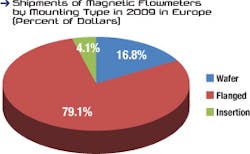Flowmeter Tech Report: A Solid Replacement for Mechanical Meters
While the magnetic flowmeter market is a mature and stable one, there are some new product developments in the magmeter market, and these new developments favor continued growth. One recent development is the advent of two-wire magnetic flowmeters. Some other device that already has power is the power source for two-wire meters. As a result, two-wire meters are lower in cost. These meters are becoming more popular with users, as they provide added cost savings.
The market for high-strength DC magnetic flowmeters is an important reason for the growing popularity of magnetic flowmeters. High-strength DC meters are better able to handle noise and are a major reason why users are making the shift from AC to DC meters.
Flowmeter suppliers are increasing the accuracy levels of their magnetic flowmeters. Even though the majority of magmeter revenues are from meters with stated accuracy of 0.5 percent, over 20 percent of magmeter revenues are from flowmeters with accuracy levels better than 0.5 percent. This percentage will improve as more magnetic flowmeter suppliers improve the accuracy of their meters.
Jesse Yoder, Ph.D., is president of Flow Research Inc. in Wakefield, Mass., a company he founded in 1998. He has 22 years of experience as an analyst and writer in process control. Yoder specializes in flowmeters and other field devices, including pressure and temperature products. He has written over 110 journal articles on instrumentation topics. Dr. Yoder can be reached at [email protected].
www.flowmags.comAbout the Author
Jesse Yoder
Jesse Yoder, Ph.D., is president of Flow Research Inc. He has 30 years of experience as an analyst and writer in instrumentation. Yoder holds two U.S. patents on a dual-tube meter design and is the author of "The Tao of Measurement," published by ISA. He may be reached at [email protected]. Find more information on the latest study from Flow Research, "The World Market for Gas Flow Measurement, 4th Edition," at www.gasflows.com.

